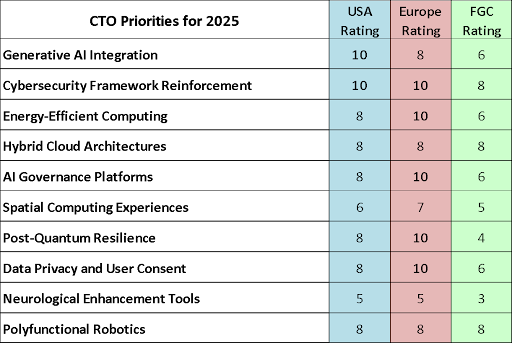Riding the Digital Wave: How 2025 Will Redefine the CTO’s Journey
 In 2025, CTOs face a pivotal moment where strategic vision and adaptability will redefine their impact. This year represents an opportunity to pivot from simply managing technological infrastructure to actively driving business transformation.
In 2025, CTOs face a pivotal moment where strategic vision and adaptability will redefine their impact. This year represents an opportunity to pivot from simply managing technological infrastructure to actively driving business transformation.
The digital landscape is evolving rapidly, presenting both significant opportunities and formidable challenges. To succeed, CTOs must exhibit bold leadership, embracing emerging technologies and aligning them seamlessly with business strategies.
Introduction
2025 looms with a technological landscape that promises to reshape industries and redefine competitive advantage. For Chief Technology Officers (CTOs), the stakes have never been higher, and neither have the opportunities. To not only survive but thrive in the coming year, here are the 10 mission-critical priorities every CTO should focus on—unpacked in the style that IEC Rebel’s Digest readers know and love.
Before we delve into the 2025 CTO priorities, here’s a brief summary to clarify the distinct roles of a CTO and CIO for a better understanding. In essence, the CTO is a visionary who looks outward, driving the company’s external technology roadmap and ensuring the business stays ahead of market trends. The CIO, meanwhile, is the operational mastermind who looks inward, managing the company’s tech backbone and aligning it with day-to-day business needs. Both roles are crucial, and in the fast-paced tech landscape of 2025, organizations that foster strong collaboration between their CTOs and CIOs will stand the best chance of driving innovation while maintaining robust operational stability.
- Navigating the Generative AI Gold Rush
Generative AI isn’t just a buzzword—it’s the pivot point around which digital transformation is accelerating. In 2025, CTOs must prioritize turning generative AI from a nifty experiment to an operational powerhouse. Think hyper-personalized marketing, autonomous content generation, and AI-driven creative design. But don’t just throw models at problems—focus on leveraging AI responsibly and transparently, ensuring that the algorithmic magic doesn’t come with a PR nightmare about data ethics or skewed biases.
- Reinforcing Cybersecurity Frameworks
With disinformation campaigns and AI-fueled cyberattacks on the rise, 2025 will be a minefield for unprepared organizations. CTOs need to revisit and revamp cybersecurity architectures, integrating disinformation security and post-quantum cryptographic protocols. The mission is clear: safeguard not just data but the very trust that anchors your digital relationships. Secure supply chains, enhance encryption methodologies, and, crucially, educate your workforce. The weakest link remains human error; turn it into your greatest asset through rigorous training.
- Architecting Energy-Efficient Computing
Sustainability isn’t just a “nice-to-have” anymore—it’s a boardroom imperative. As eco-conscious regulations tighten and the pressure to achieve net-zero emissions mounts, CTOs need to champion energy-efficient computing solutions. Whether it’s transitioning to liquid-cooled data centers or deploying more resource-efficient algorithms, aligning tech strategies with environmental goals will no longer be optional. The bonus? Energy-efficient operations often translate to significant cost savings, proving that green tech is not only responsible—it’s profitable.
- Scaling Hybrid Cloud Architectures
Gone are the days when a cloud-only or on-premises-only strategy sufficed. 2025 is all about fluidity, the seamless blend of cloud, edge, and on-premises systems. The hybrid cloud approach is where agility meets optimization, enabling organizations to pivot workloads between environments based on performance needs and cost constraints. CTOs should prioritize cloud-agnostic technologies and train their teams to manage cross-platform architectures that can shift gears in real time.
- Investing in AI Governance Platforms
As AI embeds itself deeper into decision-making processes, the risk landscape grows more complex. Enter AI governance platforms—a CTO’s command center for transparency, compliance, and ethical AI practices. Prioritizing this not only curtails legal risks but also builds public trust in how your company uses AI. CTOs should look at platforms that can integrate seamlessly with existing systems and provide comprehensive audit trails, automated reporting, and adaptive governance models.
- Pioneering Spatial Computing Experiences
The future of user engagement lies at the intersection of reality and simulation. Spatial computing, encompassing AR, VR, and mixed reality, promises new realms for customer interaction and employee training. But CTOs should think beyond flashy demos. Prioritize projects that bring real ROI—think virtual showrooms that revolutionize retail or mixed reality tools that cut training times in half. Get your developers skilled in creating seamless, multi-sensory experiences that bridge the gap between physical and digital realms.
- Optimizing for Post-Quantum Resilience
Quantum computing isn’t just theoretical anymore—it’s knocking on the door. As this nascent technology grows, traditional encryption methods face obsolescence. CTOs should act now to future-proof their organizations by investing in post-quantum cryptography (PQC) and quantum-resistant algorithms. This isn’t just about protecting trade secrets but ensuring the longevity of trust in your digital ecosystem. By 2025, building quantum awareness into your strategy is the insurance policy your data deserves.
- Championing Data Privacy and User Consent
In a world increasingly distrustful of how data is handled, privacy-first strategies are critical. This isn’t just about complying with GDPR or CCPA; it’s about anticipating the next wave of regulations and designing systems that respect user consent by default. CTOs should prioritize investments in technologies that automate data masking, enhance user transparency, and simplify data access management. Leading with privacy positions your company not just as compliant but as a steward of customer confidence.
- Empowering with Neurological Enhancement Tools
It might sound like sci-fi, but brain-machine interfaces (BMIs) are edging into practical territory. These technologies, capable of bridging neural activity with external devices, could redefine productivity and accessibility in the workplace. For CTOs, investing in exploratory partnerships and pilot programs for BMIs might position their companies as pioneers in this field. From aiding workers with disabilities to opening up new interfaces for collaboration, neurological tools could reshape the very concept of human-computer interaction.
- Orchestrating Polyfunctional Robotics
The age of the single-task robot is waning. Polyfunctional robots—machines capable of seamlessly switching between various tasks—are set to transform industries from logistics to healthcare. The forward-thinking CTO will prioritize the deployment of these adaptable machines to boost operational efficiency and reduce reliance on manual, repetitive work. Key here is ensuring these robotic systems can integrate smoothly with existing workflows and are accompanied by AI-driven analytics for real-time performance optimization.
Final Thoughts: From CTO to CTT (Chief Tech Transformer)
2025 is not just another year on the digital timeline; it’s the year where strategic vision and tech adaptability will redefine what it means to be a CTO. The role is evolving beyond managing infrastructure to transforming entire business models. It’s about reading the waves of change and being audacious enough to surf them, not just stay afloat.
Regional Observations with Importance Rating from 1 to 10:

Analysis of Differences:
- Generative AI Integration:
- USA: High priority due to the strong focus on innovation, digital products, and content creation industries.
- Europe: Important, but slightly less so, influenced by stricter regulations on AI use and data privacy.
- Fast Growing Countries: Growing in relevance, but constrained by budget priorities and infrastructure.
- Cybersecurity Framework Reinforcement:
- USA and Europe: Both regions rate this as critical due to increased cyber threats and regulatory compliance needs.
- Fast Growing Countries: Important but may face challenges due to resource limitations and less mature IT infrastructure.
- Energy-Efficient Computing:
- Europe: Highest priority as sustainability is a major focus driven by regulations like the EU Green Deal.
- USA: Important, but sustainability is often balanced against cost and efficiency.
- Fast Growing Countries: Lower, due to pressing needs for basic infrastructure and rapid development that sometimes takes precedence over sustainability.
- Hybrid Cloud Architectures:
- USA, Europe, and Fast Growing Countries: All rate this as important due to the flexibility, scalability, and cost-efficiency benefits of hybrid cloud solutions.
- AI Governance Platforms:
- Europe: High priority due to the region’s proactive stance on ethical AI and regulatory frameworks.
- USA: Important but typically driven by industry standards rather than regulatory mandates.
- Fast Growing Countries: Less prioritized but gaining attention as AI adoption increases.
- Spatial Computing Experiences:
- Europe: Slightly higher importance due to the region’s investments in AR/VR for various industries.
- USA: Steady interest, especially in sectors like retail and gaming.
- Fast Growing Countries: Still emerging due to cost and technical barriers.
- Post-Quantum Resilience:
- Europe: High priority as it aligns with the continent’s focus on future-proofing technology.
- USA: Important but often more of a medium-term focus.
- Fast Growing Countries: Lower importance due to more immediate technological needs and limited resources.
- Data Privacy and User Consent:
- Europe: Highest rating due to stringent data protection laws like GDPR.
- USA: Important, with a growing emphasis on consumer privacy, though regulation varies by state.
- Fast Growing Countries: Increasing in importance as data protection laws start to take shape.
- Neurological Enhancement Tools:
- USA and Europe: Moderate interest primarily in advanced tech sectors.
- Fast Growing Countries: Low importance, as focus remains on fundamental tech growth rather than niche advancements.
- Polyfunctional Robotics:
- USA, Europe, and Fast Growing Countries: High relevance in manufacturing, logistics, and healthcare for operational efficiency, especially as automation becomes more vital in labor-constrained markets.
Conclusion:
While cybersecurity, AI governance, and data privacy top the list in Europe due to stricter regulations and ethical considerations, the USA prioritizes generative AI and hybrid cloud as strategic drivers of growth and innovation. Fast-growing countries focus more on cost-effective solutions and foundational technologies but show increasing interest in automation and cloud as they modernize their industries.
CTO Go To’s: After Reading the 2025 Playbook: Align, Compare, and Strategize
Your next steps? Take this roadmap and carve out your organization’s tailored playbook. Whether it’s pushing the envelope with agentic AI or investing in sustainable, future-proof computing, the CTO of 2025 must embody not just technological expertise but a keen eye for innovation that translates to tangible, sustainable growth.
The tech landscape waits for no one. Are you ready to lead—or to be led? The answer, dear CTOs, is in the priority you set today.
Last but not Least: If you’re facing challenges and wondering how others are managing similar issues, why not join The Leadership Collective Community? It’s a peer group and webcast platform designed for leaders to exchange insights and experiences.
Introducing the IEC Knowledge Network Free Membership – Your Gateway to Seamless Access!
We are thrilled to present a new service that goes beyond the ordinary download experience. In addition to offering you the ability to download the things you love, we are delighted to introduce the IEC Knowledge Network Free Membership.
The Free Membership option grants you access to our library of articles and videos, without the need for tedious registrations for each piece of content.
The publication serves as a trusted resource to support executives in their pursuit of sustainable and successful global expansion. In addition the IEC Practitioners are available to discuss your specific challenge in more detail and to give you clear advise..
Take advantage of this valuable resource to accelerate your global expansion journey


